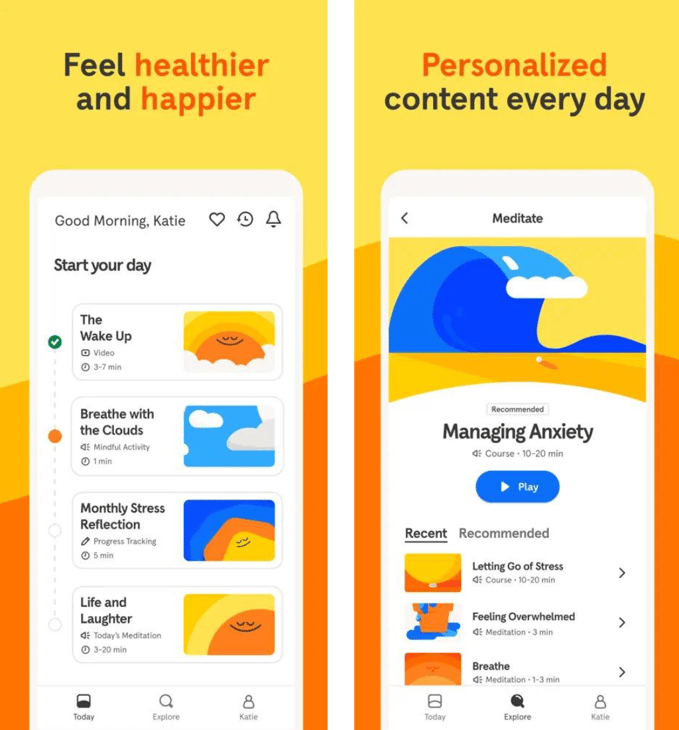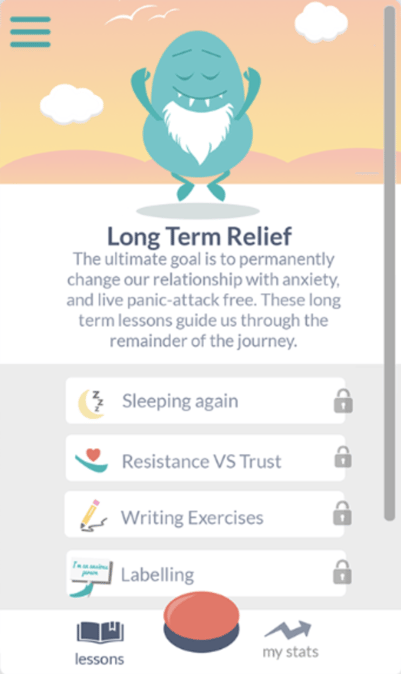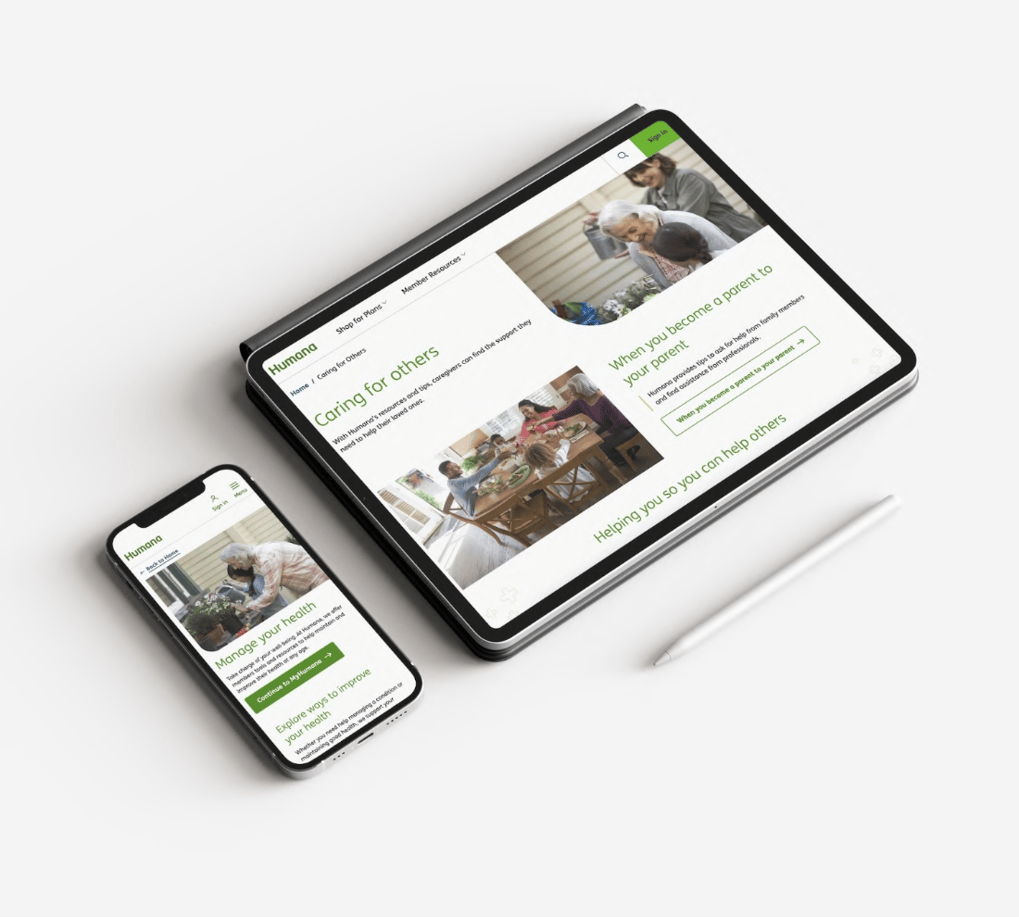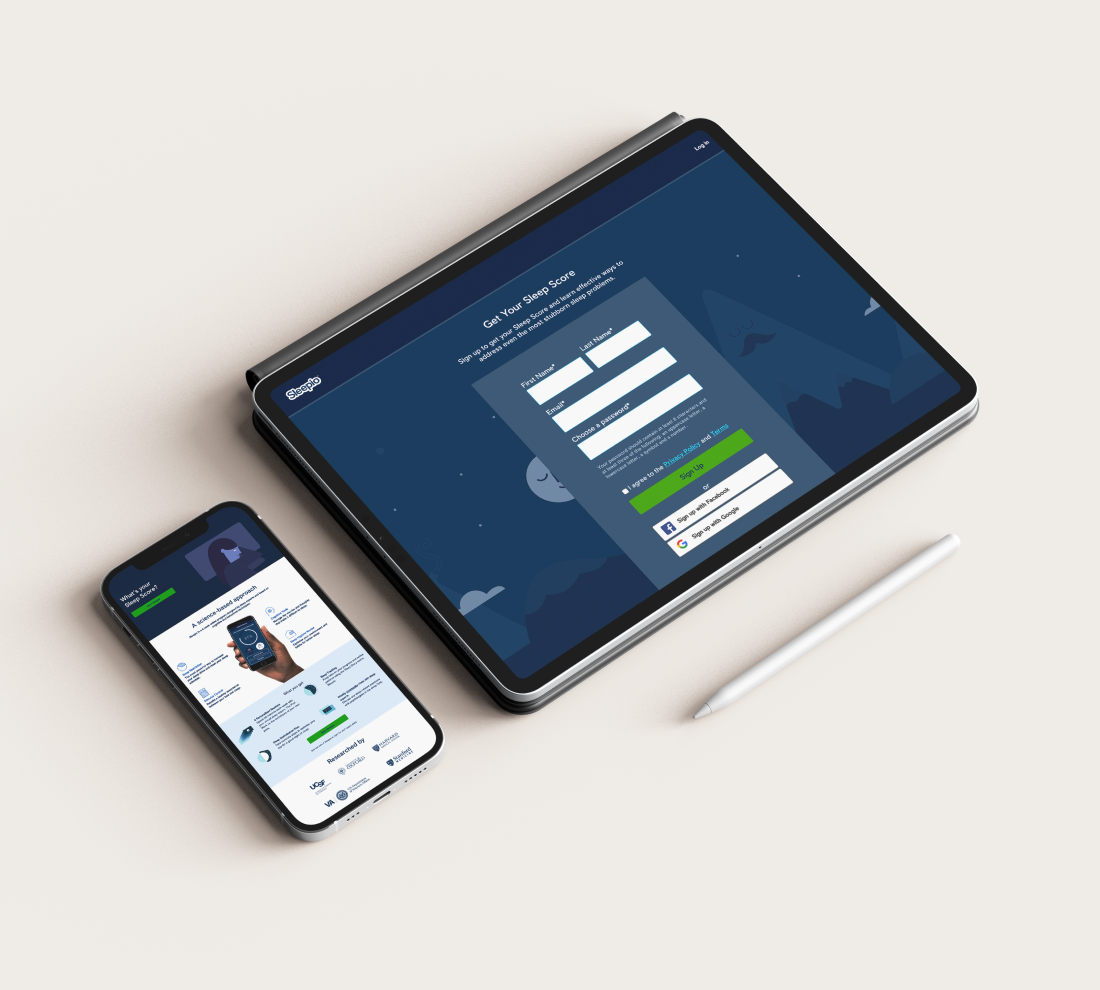In 2019, the World Health Organization (WHO) reported a staggering statistic: 970 million people worldwide, one in every eight people, were grappling with a mental disorder. The levels of anxiety and depression, already the most common mental disorders, were further exacerbated by the onset and rapid spread of COVID-19, leading to what many scientists call a Mental Health Pandemic among young people [5]. The market swiftly responded, with the number of mental or behavioral health apps skyrocketing from just over 10,000 in 2019 to approximately 22,750 by 2021 [1].
One thing unites the most popular apps in the category—Headspace, Calm, and many others: the use of gamification.
Understanding Gamification in Mental Health Care
Gamification is the use of gaming elements in a non-gaming context. [2] It is often introduced into digital health apps because the “game-like” dynamics increase user engagement, reinvent routine activities, and reignite user motivation to achieve positive behavioral change.
The principle of "bounded rationality" in behavioral economics tells us that humans often act irrationally, going against their own self-interest even when they understand the consequences [3]. Ever prioritized a Netflix binge over a good night's sleep? Because we chase immediate gratification, knowing what’s good for us is not enough to always choose it. Gamification offers digital product designers a tool to make pursuing long-term health goals immediately rewarding. This, in turn, helps users stick with routines like daily meditation or cognitive-behavioral therapy long enough to start seeing the positive impact on their wellbeing.
Exploring Gamification Components
The Mechanics-Dynamics-Aesthetics (MDA) framework [4] identifies three main components of designing a gamified experience: Mechanics, Dynamics, and Aesthetics. This framework is vital in structuring the gamified elements within digital health apps. Here’s how each component is applied in mental health apps:
- Mechanics are the gamified elements that users can see and interact with on the app screen. Beyond just points and badges, mechanics can include daily check-ins, mood assessments, and therapeutic tasks that users complete to progress through levels. Each action could unlock new content or features, such as personalized mental health tips or access to advanced meditation sessions, making the journey through the app more rewarding.

Examples of the daily therapeutic tasks in the Headspace app
Leaderboards and avatars are mechanics that can be used if an app includes a social component, such as a supportive peers group. For example, SuperBetter, an app that helps to develop whole-person resilience, allows you to adopt “a secret identity” that inspires you, approach challenges in “squads” with other users, and invite “allies” to encourage you on your personal journey.- Dynamics are about the underlying processes that drive user engagement. They include goal setting and tracking progress, rewards, instant feedback, customization, and interactivity. Happify, a positive psychology-based app, offers more than 70 tracks dedicated to goals such as Conquering Negative Thoughts or Fighting Loneliness. Each track involves different in-app and real-world activities that adapt to the user's progress. Depending on the skills a user develops while engaging with the activity, a user is rewarded with "savor," "thank," "aspire," "give," "empathize," or "revive" points.
Goal setting is important in cognitive behavioral therapy and is often incorporated into the onboarding flow of apps that help users with addiction management, as well as with anxiety and depression. Setting specific and measurable goals allows a user to track progress over time and experience feelings of control and success, which may counter common feelings of hopelessness and worthlessness. For example, the I am Sober app helps a user to set (and meet) a specific and measurable goal of staying sober for one more day. As a reward, the app shows how much money - and calories, where applicable - a user has saved by overcoming the addiction day after day.
.png?width=679&height=731&name=i%20am%20sober%20screens%20(1).png)
Goal-setting and progress tracking as examples in the I am Sober app
- Aesthetics are the emotional effects that these elements evoke in the users, such as feelings of curiosity, motivation, fun, connection, and winning. The MDA framework authors offer this taxonomy of aesthetic goals: 1. Sensation - Game as sense-pleasure; 2. Fantasy - Game as make-believe; 3. Narrative - Game as drama; 4. Challenge - Game as obstacle course; 5. Fellowship - Game as a social framework; 6. Discovery - Game as uncharted territory; 7. Expression - Game as self-discovery; 8. Submission - Game as a pastime. Often, mental health apps pursue multiple aesthetic goals. eQuoo, an app that teaches psychological skills, uses fantasy world-building, interactive narration with elements of historical and teen drama [6], adventurous time and space travel, and self-discovery to help users boost their emotional resilience.
.png?width=679&height=698&name=equoo%20(1).png)
Fantasy world-building as an element of gamification in the eQuoo app
Aesthetics is also about the look and feel of the app. While many mental health apps strive to create an inviting and safe virtual environment, soothing colors and gentle animations are not the only way to achieve this. For example, SupperBetter goes bold with colors and empowers you to go for “Epic Wins” and battle “Bad Guys” (i.e., common bad habits/traits such as self-criticism).
.png?width=698&height=751&name=SupperBetter-%20gamification%20in%20mental%20health%20care%20apps%20(2).png)
Examples of gamification aesthetics from SupperBetter
How to Implement Gamification in a Mental Health Care App Meaningfully?
Mental health apps often lose most of their users within the first two weeks after installation [7], [8]. While gamification can help promote user engagement and duration of visits, it's crucial that these apps do not merely optimize for time spent on the app but focus on meaningful interactions that contribute to the user's mental health.
At a panel on the Paradox of Loneliness and Technology at SXSW’24, we spoke with Leslie Witt, Chief Product & Design Officer at Headspace, a mindfulness & meditation app, about the importance of optimizing not just for engagement but for outcomes. One of the user outcomes the company focuses on is improvement in depression symptoms. A recent study conducted by Headspace showed a 29% decrease in depression symptoms after 8 weeks of a mindfulness meditation program delivered via the Headspace app. The study revealed that the number of meditation sessions was indeed associated with outcomes and that there was only a benefit from the intervention for participants who completed more than 10 meditation sessions within the 8 weeks. In this case, using gamification, nudges, and other means to increase user engagement leads to positive mental health outcomes.
Some mental health apps design guardrails to ensure that users are not encouraged to spend more time in the app than necessary to achieve a therapeutic effect. SuperBetter portions the daily activities in just 10 minutes a day, while some of Happify’s suggested activities require users to venture outside the home or interact with others in the real world.
Step-by-Step Instructions for Implementing Gamification in a Mental Health Care App
1. Define Therapeutic Goals. Start by clearly defining the therapeutic outcomes you want to achieve. Rootd’s therapeutic goal is to provide relief from anxiety and panic attacks. Therefore, its gamification strategy is directed toward explaining, training, and encouraging practices (guided deep breathing, anxiety journal, soothing visualization, and an actual panic button) that help prevent and stop panic attacks.
 An example of aligning gamification with a therapeutic goal by Rootd
An example of aligning gamification with a therapeutic goal by Rootd
2. Identify Motivating Gamification Elements. Choose gamification elements that align with your therapeutic goals. This could include:
- Progress Tracking. Implement features like visual progress bars or levels to show users how they are advancing toward their mental health goals.
- Rewards. The progress a user is making is often rewarded by some form of a digital token, like a badge, but few apps provide context on why and how to use the acquired points or how they are connected to the mental health outcomes a user is pursuing. The mental health app creators can borrow ideas from broader digital health and fitness companies. For example, when you use Humanity, every mood log, meditation, or yoga session contributes to your H Score, a representation of how your activities and choices might be impacting your biological age. Sweatcoin rewards your daily steps with a digital currency you can spend on cool products or donate to charity.
- Challenges. Incorporate challenges that are achievable and aligned with therapeutic practices, such as completing a 5-day meditation streak.
There is a balance between the game value (ie, to motivate or persuade users to adopt specific healthy behaviors or change maladaptive behaviors) and justifying the potential impact on the therapeutic value (ie, the capacity to reduce psychological symptoms). [9] For example, this study analyzed 70 mental health apps and found that most of them have 5 gamification elements, but that the increase in the number of techniques did not correspond to an increase in engagement. [10] Adding more game elements to improve engagement might result in a more enjoyable game experience; however, the underlying therapeutic aspect might be negatively influenced [11].
3. Allow users to customize their experience. Personalization of the treatment plans or recommended activities is often based on the information about individual needs, goals, and preferences submitted during onboarding via card sorting, questionnaires, or story-driven quests. Following adaptive personalization happens based on user performance, progress, and feedback.
4. Incorporate Feedback Mechanisms. Provide immediate, constructive feedback. This could be positive reinforcement when users complete a task or gentle reminders if a user misses a session. Feedback should be supportive and designed to encourage continued effort rather than induce guilt.
5. Test and Iterate. This is relevant not only for gamified mental health apps but any digital products: involve your target users in the process of creation as early as possible. Involving users at early stages of design, for example, via evaluation of wireframes and testing clickable prototypes before building an MVP can ensure no resources are wasted on building something that users don’t find helpful. Is the tone of the app too much reminiscent of the paternalistic doctor-patient relationships? Is your gamification too clunky and would benefit from a bit of humor, for example of a kind that Woebot shows? You won’t know until you ask your users.
Get a Free Copy of 'What To Expect From A Clickable Prototype'
.png?width=479&height=269&name=clickable%20prototype%20form%20cover%20(5).png)
6. Monitor Outcomes vs. Engagement. Regularly review analytics to understand how gamification is influencing user behavior and mental health outcomes. The mood check-ins before and after activities or during onboarding and after two weeks of usage can be useful measurement tools. Adjust the gamification elements if they increase engagement but do not contribute to or potentially detract from the intended therapeutic outcomes.
7. Educate Users. Make sure users understand how the gamification elements connect to their mental health goals. This education can help them appreciate the benefits of their activities within the app, making the gamification aspects more meaningful.
By following these steps, product designers and developers can create mental health apps that not only engage users but also promote real and lasting improvements in mental health.
Future Trends and Challenges
Regulatory Challenges and FDA Approval of Gamified Mental Health Apps
Mental health apps that claim to diagnose, treat, or manage mental health conditions, are considered medical devices and must obtain FDA approval to demonstrate efficacy and safety. In 2020, EndeavorRx, built by Akili Interactive, became the first FDA-approved game-based digital therapeutic device to improve attention function in children with attention deficit hyperactivity disorder (ADHD).
Usage of gamification, AI, or large language models in a mental health app adds an additional level of complexity to regulatory recognition of an app as a medical device. The process is intricate and might require clinical trial data to support the claims made by the app. This regulatory scrutiny ensures user safety but poses a significant barrier to entry for new developers.
Prescription Mental Health Apps with Gamification
In 2018, clinicians in the US started to prescribe reSET by Pear Therapeutics, Inc. for their patients with Substance Use Disorder (SUD). This became the first FDA-authorized prescription digital therapeutic commercially available in the country. Since then, prescription apps with and without gamification have started to address mental health conditions from insomnia (Sleepio) to, recently, depression (Rejoyn). From the business perspective, qualifying as a prescription mental health app opens new market channels as well as access to a broader population thanks to coverage by health insurance plans. While not every prescription app has to be a medical device, demonstrating efficacy and safety of the app through clinical trials or well-documented research is still required.
Integration With Wearables For Further Personalization
Integrating wearables into mental health apps allows to automate gathering of additional wellbeing-related data and adjust a user journey based on the impact sleep and physical activity have on their mental state. For example, FitBit allows users to track mindful days via integrations with Headspace and Calm and observe how regular meditations impact their resting heart rate. The Oura ring connects to Headspace to help members understand how their bodies handle and recover from physiological stress, and respond to guided breathwork exercises and meditations.
However, connected wearables go far beyond activity trackers. For instance, Muse connects to a brain-sensing headband to give you real-time audio feedback during meditation, while Roga delivers pulsed electrical stimulation via the headset, which, when combined with guided app-based therapies, offers relief from stress. Mental health app integrations with metabolic monitoring devices, such as continuous glucose monitors (CGMs), could be the next step.
Conclusions
Adding gamification to your app helps users tap into the feeling of playing and winning in pursuit of their mental wellness goals, thereby improving user adherence to therapeutic activities.
When deciding which gamification elements to add to your user journey, ensure you optimize for therapeutic outcomes and not just for the time spent in the app. Moreover, nothing helps better to stay focused on user outcomes than engaging with your target users at every stage of your ideation, design, and development journey.
Need a team to help you craft a gamified UX, test with users, and develop your digital health app? Check out our Product and UX services and Digital Health projects.
Get a Free Copy of 'Delivery of Custom Apps'
%20(1).png?width=479&height=340&name=delivery%20of%20custom%20apps%20(2)%20(1).png)
Resources
- Bedor Hiland, Emma. Therapy Tech : The Digital Transformation of Mental Healthcare. Minneapolis, MN: University of Minnesota Press, 2021. Print.
- Deterding, S., Sicart, M., Nacke, L., OʼHara, K., and Dixon, D. Gamification: Using game-design elements in non-gaming contexts. Proc. CHI EA ‘11, ACM Press (2011), 2425-2428. Accessed on April 16, 2024 https://www.researchgate.net/publication/221518895_Gamification_Using_game_design_elements_in_non-gaming_contexts
- Phillips, Jr, Chadi Nabhan, and Bruce A Feinberg. “The Gamification of Healthcare: Emergence of the Digital Practitioner?” The American journal of managed care 25.1 (2019): 13–15. Print.
- Hunicke, R., LeBlanc, M. and Zubek, R. (2004) 'MDA: A formal approach to game design and game research', in Proceedings of the AAAI Workshop on Challenges in Game AI, 1722. Accessed on April 16, 2024 https://users.cs.northwestern.edu/~hunicke/MDA.pdf
- Schubotz D, Roche R, Manzi J, McKnight M. A Mental Health Pandemic? Assessing the Impact of COVID-19 on Young People’s Mental Health. International Journal of Environmental Research and Public Health. 2023; 20(16):6550. Accessed on April 16, 2024: https://doi.org/10.3390/ijerph20166550
- Litvin S, Saunders R, Jefferies P, Seely H, Pössel P, Lüttke S. The Impact of a Gamified Mobile Mental Health App (eQuoo) on Resilience and Mental Health in a Student Population: Large-Scale Randomized Controlled Trial. JMIR Ment Health. 2023 Jul 21. Accessed on April 16, 2024: https://www.ncbi.nlm.nih.gov/pmc/articles/PMC10403802/
- Bauer, M., Glenn, T., Geddes, J. et al. Smartphones in mental health: a critical review of background issues, current status and future concerns. Int J Bipolar Disord 8, 2 (2020). https://doi.org/10.1186/s40345-019-0164-x
- Baumel, A., Muench, F., Edan, S. and Kane, J.M. (2019) 'Objective user engagement with mental health apps: systematic search and panel-based usage analysis', Journal of medical Internet research, 21(9), e14567. https://doi.org/10.2196/14567
- Siriaraya, P., Visch, V., Boffo, M., Spijkerman, R., Wiers, R., Korrelboom, K., Hendriks, V., Salemink, E., van Dooren, M., Bas, M., & Goossens, R. (2021). Game Design in Mental Health Care: Case Study-Based Framework for Integrating Game Design Into Therapeutic Content. JMIR serious games, 9(4), e27953. https://doi.org/10.2196/27953
- Auf H, Dagman J, Renström S, Chaplin J. Gamification and nudging techniques for improving user engagement in mental health and wellbeing apps. Proceedings of the Design Society. 2021;1:1647-1656. doi:10.1017/pds.2021.426 https://www.cambridge.org/core/services/aop-cambridge-core/content/view/EB2BEF667BFAE42422FE27C04FA2B0A3/S2732527X21004260a.pdf/gamification-and-nudging-techniques-for-improving-user-engagement-in-mental-health-and-well-being-apps.pdf
- van Dooren, Marierose & Siriaraya, Panote & Visch, Valentijn & Spijkerman, Renske & Bijkerk, Laura. (2019). Reflections on the design, implementation, and adoption of a gamified eHealth application in youth mental healthcare. Entertainment Computing. 31. 100305. https://www.researchgate.net/publication/333839025_Reflections_on_the_design_implementation_and_adoption_of_a_gamified_eHealth_application_in_youth_mental_healthcare

.jpg?width=300&name=gamification%20in%20mental%20health%20apps%20-%20blog%20cover%20image%20(6).jpg)


COMMENTS